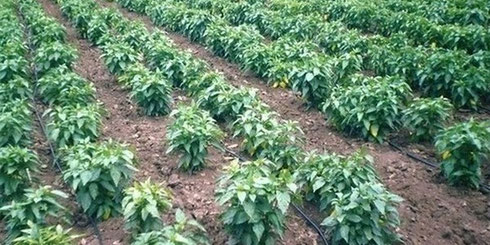 The heat-loving pepper requires proper care, otherwise you will not get high yields. Moreover, in most regions of Russia, because of the harsh climate, this crop is grown in greenhouses, under shelters.
The heat-loving pepper requires proper care, otherwise you will not get high yields. Moreover, in most regions of Russia, because of the harsh climate, this crop is grown in greenhouses, under shelters.
Open ground is a privilege of the southern regions, there you can not limit yourself to the choice of sweet pepper varieties. For the middle zone, and even more so, for regions such as the Urals, Northwest, and Siberia, it is recommended to choose early ripe varieties that are resistant to the vagaries of weather. But in a favorable season, gardeners of these regions also collect good pepper crops from open ridges, subject to proper agricultural practices.
Content
Pepper in open ground or greenhouse - description
Pepper is a culture with long growing periods, therefore it is grown through seedlings, and only then it is determined with planting in a permanent place. You can grow it directly in the beds, choosing a sunny, sheltered from the winds place, you can cultivate it under arcs with a film or non-woven material. It all depends on climatic conditions, variety, as well as care. We will talk about the features of care both in the open ground and in the greenhouse.
Rules for care after planting in the ground
Having decided to grow pepper in the ridges in the open air, they determine in advance a suitable place for it and prepare the site.
Site selection and soil preparation
Ridges should be located in a well-lit area, with only a small penumbra allowed. The soil is fertile, loose, water-intensive and breathable. Pepper likes to grow on neutral or slightly acidic soils, but ridges with acidic soil are not suitable for culture.
To neutralize acidity on too acidic soils, add wood ash, make lime fluff. Moss application will help to change the acidity of alkaline soils (it is better to take from peat bogs).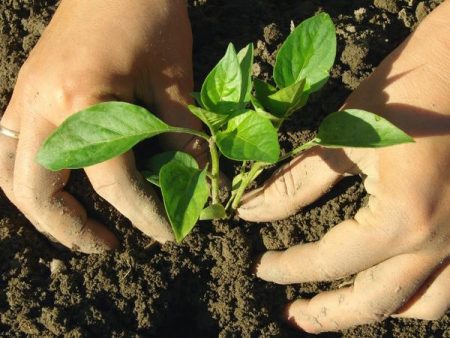
The ridges are dug up in the fall, then rotted manure is brought in (about 5-6 kg per square meter). Phosphoric and potassium supplements are recommended for spring digging.
It is required to observe crop rotation, returning pepper to the same place no earlier than 4 years later. You can not grow it after crops such as:
- potatoes;
- eggplant;
- Tomatoes
These are all cultures related to peppers that make up the vast family of nightshade. Their diseases are the same, therefore, there is a great risk that pepper can "catch" any infection of vegetables that grew on this ridge before it. But it is grown after pumpkin, legumes, all kinds of cabbage, cucumbers.
Transplanting
Pepper is planted in the ground only when stable warm weather sets in. The soil should warm up to + 14ºC ... + 16ºC (indicators at a depth of 10 cm), and in many regions this time only begins in early June. You can plant culture in the last week of May, it all depends on the weather in a particular season and climate.
Usually in the North-West, in Siberia, gardeners do not risk, and if pepper is planted a little earlier in the greenhouse, then you should not hurry with planting on open ridges. A few days will not be critical, but your seedlings will not fall under possible cooling.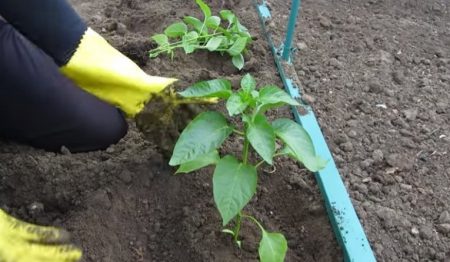
For a more successful adaptation, the peppers begin to harden approximately 10-14 days before the move. They are accustomed to outdoor temperature, sun rays.First, peppers are taken out for about 15-30 minutes, gradually bringing the time spent in the air to several hours.
When planting, it is advisable to use the transshipment method, removing peppers from containers (cups, drawers) along with an earthen lump. If seedlings were grown in peat pots, in home-made paper cups, then they are planted in holes directly with them. Seedlings should be approximately 55-60 days old.
Wells are made on the ridge, maintaining the distance and the landing pattern. It is recommended to grow peppers, taking into account the characteristics of the variety and plant height:
- for undersized, you can leave up to 20 cm between plants;
- medium-sized peppers grow from each other at a distance of 30-35 cm;
- tall varieties and hybrids will need to leave from 40 to 60 cm.
Typically, small varieties of pepper are grown on ridges, but in any case, it is important to take care of the installation of supports in advance. Wells shed with warm, settled water, allow moisture to absorb a little into the soil. Then planted in the wells of the plant, making sure that the root neck is at the level of the soil. Peppers are not recommended to be deepened, it is advisable to plant them at the same level as they grew in pots.
The ground near the stem is neatly compacted, you can immediately, or you can mulch in two days the surface of the soil with hay, rotted compost, measles, chopped straw.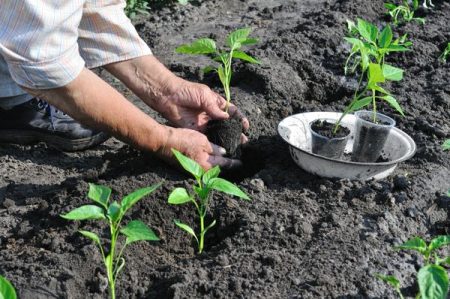
Protection against cold and heat
To plant a crop, it is advisable to choose a cloudy day so that the plant does not burn the sun for the first hours. If this is not possible, schedule work in the evening. After planting, the peppers should be slightly shaded, and here the best option would be to use a non-woven material.
This material will provide the planted seedlings with comfortable conditions, close it from the hot rays of the sun, and if necessary protect it from cold snap. Many gardeners specifically install arches on ridges, and then cover them with agril, lutrasil, spanbond.
About a week peppers are not watered, and only after 6-7 days can you irrigate the soil with water. But it all depends on the weather and the state of the plants themselves, the recommendations are conditional, and so you need to orient in each specific situation in your own way.
Watering
In order for the fruits of the pepper to be juicy and tasty, it is necessary to organize the correct watering. For plants in the garden, this is especially important, since rains do not have a schedule and it is necessary to carefully monitor the condition of plants and soil moisture.
If rainfall occurs regularly, then you can do without watering. Usually pepper is watered every 5-6 days, after the appearance of the ovaries, you can water more often, but only as the soil dries. Those who, due to the work schedule, manage to come to the site only on weekends, it is recommended to mulch the soil. This will protect the plants from drought, ensure a normal level of moisture in the soil, and eliminate weeds. A layer of mulch is made from 6 to 10 cm; as the thickness decreases, mulch (hay, sawdust, peat) is added.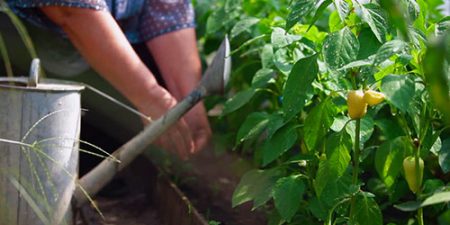
It is watered only with warm, necessarily settled water. With frequent rains, loosening is carried out to prevent stagnation of moisture in the soil.
Weeding and cultivation
In the absence of mulching, the soil near the peppers must be carefully loosened. Since most of the root system is located in the upper soil layer, the soil is loosened very carefully, trying not to touch the roots of the plant.
After watering, a crust forms on the soil, it slows the penetration of air into the ground, which negatively affects the roots of plants.Light regular loosening destroys the crust, provides oxygen access to the soil, contributes to the better development of pepper roots, and hence the plant itself.
Some gardeners during the appearance of buds and mass flowering of pepper bushes carry out their hilling. Loosening is not only the destruction of the crust, but also the disposal of annoying weeds. In open ground (especially after rain), weeds grow very quickly, and without weeding can drown peppers. So you should regularly loosen and weed the planting, and even better - use mulch.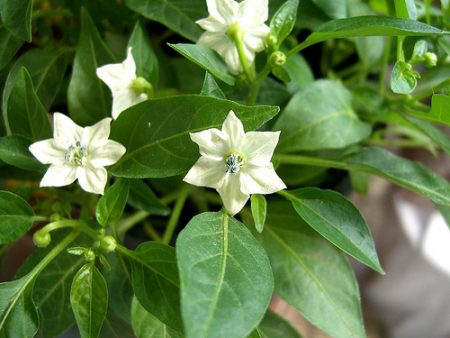
Top dressing
With well-fertilized soil on the ridges, pepper will have enough nutrition for the first time. But nevertheless it is recommended then to carry out several top dressings. Usually, during the season, plants are fed 3-4 times using organics, wood ash, complex fertilizers or ready-made compounds.
The first time top dressing is carried out not earlier than 12-14 days after disembarkation at a permanent place. You can take a mullein bred in water or bird droppings (1:10 and 1:20).
During the flowering period, superphosphate, as well as potassium humate, is suitable. If superphosphate is taken, it is recommended to grind it beforehand. For the third top dressing (14 days after the second) ash is insisted, peppers can also be fed with superphosphate infusion. In proportions: ashes take about two glasses per bucket, two tablespoons are enough for superphosphate.
An excellent “lunch” for peppers is an infusion of herbs, for which nettles are most often used. It is necessary to grind the plants, put them in a tank (half), pour warm water to the top and close. Insist for about 3-4 days, then infusion is diluted with water (liter per bucket) and watered peppers. The same infusion is suitable for eggplant, tomatoes. You can add ash to the composition.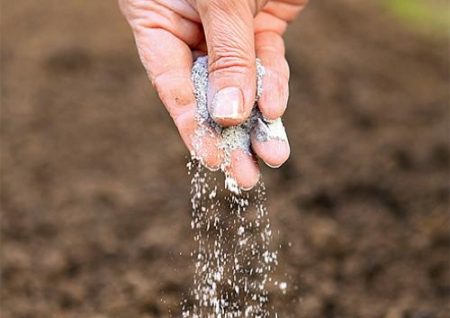
By observing the plants, you can determine what components are lacking in the nutrition of peppers. With a lack of nitrogen, peppers grow poorly, the leaves are small, light green, with a dull gray tint.
With a deficiency of potassium in the peppers, the leaves begin to dry out and curl, but if there is little phosphorus, then from the bottom side the leaf blades will be covered with purple spots. With such changes in the leaves, it is urgent to make top dressing with suitable fertilizers.
In addition to top dressing, wood ash is also used to deter pests, as a prophylaxis against various diseases. In open ground, aphids and spider mites harm peppers, in the evening they perform slug attacks. Garlic infusion for spraying, ash infusions and dusting, mustard powder and a mixture of ash and tobacco dust, scattered between the rows - these are simple but quite effective ways to prevent and control pests.
Greenhouse Pepper Care
With short and cool summers in open ground, it is difficult to provide pepper with good conditions. If there is no heat, then it is difficult to hope for a good harvest of this capricious and very heat-loving culture. Greenhouses help out, in which gardeners of even such regions as Siberia and the Northwest get very good results.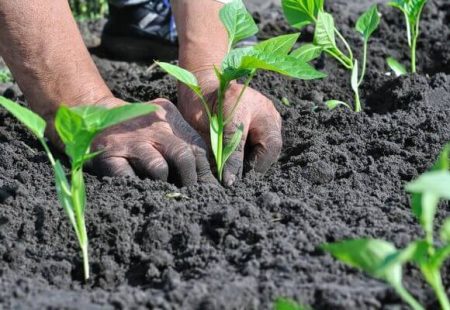
Agricultural technology of sweet pepper in greenhouses differs little from caring for plants in the open ground. The basic techniques are the same, but the following should be considered:
- Regular watering (in the greenhouse, providing the plants with moisture fully rests on the gardener);
- Airing of shelters. In greenhouses on hot days, the temperature can be very high, and humidity can be just as high. Pepper grows poorly in such conditions, so it is necessary to open the windows, doors, windows, carefully ventilating the plantings.
- It is necessary to replace the top layer of soil in greenhouses every season, it is imperative to disinfect the soil, all supports of the shelter. With long-term use of greenhouses, harmful microorganisms accumulate inside, which can be detrimental to plants. Therefore, the processing of greenhouses with special compounds for disinfection is mandatory for everyone.
- It is convenient to grow tall peppers in the greenhouse using trellises as supports. A wire is pulled over the frames, twine can be used, and as the peppers grow, they will rely on such structures. There is no desire to use trellis, then make stakes and tie stalks of pepper to them with a wide cotton ribbon.
- If you harvest your own pepper seeds at the end of summer, then sharp and sweet varieties are immediately planted in different greenhouses.
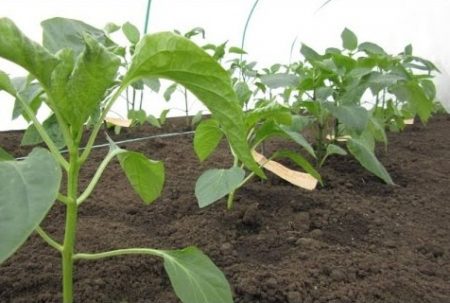
- When growing tall peppers in greenhouses, it is imperative to form plants. They make a pinch, cut off the extra lateral shoots, lower leaves, as well as the central (crown) bud of the plant.
- The wave-like nature of the yield of the crop also determined the features of the harvesting of pepper. It is advisable to take the first fruits in greenhouses at the stage of technical maturity. This makes it possible to form and grow subsequent fruits, and in general - to increase productivity. The second wave of fruits can be left to ripen on the plant.
Greenhouse irrigation frequency
For plants in the greenhouse, it is necessary to provide comfortable growing conditions:
- a sufficient amount of moisture;
- heat;
- lighting;
- food.
On the ridges peppers may be quite enough rainfall, in the greenhouse they are watered 1-2 times in 7 days. It is recommended to follow the irrigation schedule, increasing the volume of water during the flowering period. But it is important to prevent excess moisture in the soil, as in a closed space immediately increases the humidity in the shelter.
After watering, you need to ventilate the greenhouse, and the next day to carry out loosening. And again, as in open ground, mulching the soil is recommended to obtain higher yields. If possible, a drip irrigation system can be installed in the greenhouse.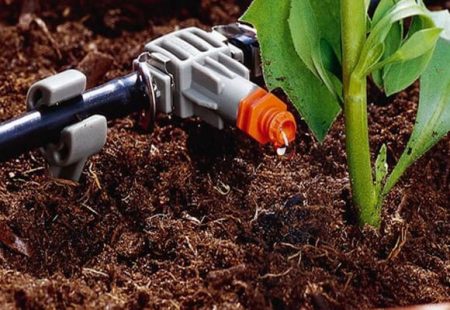
Peppers are watered very carefully, trying not to fall on leaves and ovaries. The water temperature is about + 22ºC, and regardless of where the water comes from - the well, pond, rain, it must be settled. An excess of moisture in the soil leads to the appearance of diseases in peppers, and this is always unnecessary troubles, the use of various preparations and possible crop losses. Compliance with the irrigation regime and all agricultural techniques will save you from problems.
Fertilizer application for pepper in a greenhouse when grown in a greenhouse
Another important condition for obtaining a crop in the greenhouse is the feeding of pepper. Properly organized nutrition of the culture, when peppers lack all the elements, ensures the normal development of the culture, helps to increase immunity. Peppers in the greenhouse are “fed” 3-5 times per season, given the fertility of the soil, the condition of the plants themselves. Tall crop hybrids require more nutrition, so you need to pre-harvest mullein (you can use bird droppings), complex fertilizers.
As in the open ground, the first top dressing is done with organic matter and not earlier than two weeks after the planting of peppers. It is also permissible to use urea (make an aqueous solution, 4-5 grams per bucket of water), dry nitrophosphate.
For the second top dressing, you need to take phosphate and potash fertilizers, use an ash solution. It is carried out during fruiting, strictly observing the dosage of all components. It is advisable to combine fertilizer and watering for better assimilation of pepper nutrients.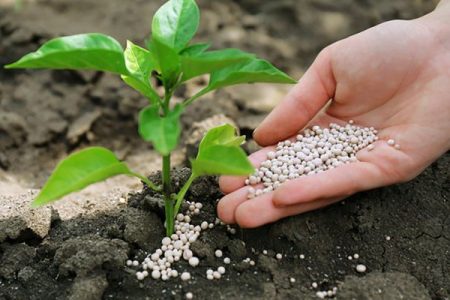
Foliar top dressing of pepper on leaves gives a good effect, so many gardeners use:
- urea solution (one teaspoon per bucket of water will be enough);
- superphosphate (treated with a composition in a bucket of water - two teaspoons);
- boric acid (take a bucket of water and breed one teaspoon of the product in it).
Extra root top dressing is especially convenient if plants require the addition of trace elements. When applied under the root, they are absorbed more slowly and worse, but when processing peppers on leaves, the results are achieved faster. If the peppers normally grow, bloom, give back the crop, you can do without spraying. Recommendations are intended to help in organizing proper care, as well as in the event of any difficulties.
Compliance with all methods, the optimal temperature, knowledge of some features of the culture will allow you to grow pepper crops, even in regions of risky farming. By the way, the experience of many summer residents only confirms this.
Reviews
Irina, Nefteyugansk
They say a lot about the fact that peppers in the exhaust gas cannot be grown in our area. And I, for lack of space in the greenhouse (I have eggplant and tomatoes there), I always plant pepper in the garden. But I always close it with lutrasil, and nothing, even some ripen right on the vine.
First, we grow seedlings in small glasses, then transfer (do not dive) into larger glasses. I make the beds warm, I plant peppers only in June. If it’s not very warm, I also keep the film on the arcs. Two waves of harvest are stable, but I only plant early varieties. I choose to be on the lecho, and for stuffing.
Ksenia, Pskov
The second year I grow peppers in a specially made greenhouse for him. Prior to that, he grew up with me, anywhere, where the place will be free, and I'll poke it there. But then her husband’s hands got to the greenhouse under the pepper and did it. I grow the second year of 40 bushes. It was a California miracle, two Dutch hybrid. The miracle is very productive, large. I found out now that I need to remove the first bud, now this year I will do so. She fed him with dung, added ash. I didn’t try to grow pepper in the open ground; unpredictable summer may be too summer. Tomatoes (kids) grow, in the greenhouse are tall, and I plant them on a bed of shorties.
Sergey, Ulyanovsk Region
I have bell peppers - one of my favorite vegetables. Over the years I have accumulated experience, I grow both in beds and in the greenhouse. Harvests are always good, but for this you need to know some secrets.
If peppers do not have buds for a long time, then most likely there is a lot of nitrogen in the soil. It is urgent to spray with superphosphate, you can also use Ovary or Bud. It is also necessary to monitor the temperature in the greenhouse. In the heat there can be above thirty degrees, so the pepper will bloom, but there will be no ovaries. It is necessary to ventilate the greenhouse, well, using the same means (Ovary, Bud) to spray.




 Calorie pepper stuffed with meat and rice - BZHU per 100 grams
Calorie pepper stuffed with meat and rice - BZHU per 100 grams Gorky pepper - the best varieties for open ground
Gorky pepper - the best varieties for open ground Hot pepper seeds - the best varieties for open ground and reviews
Hot pepper seeds - the best varieties for open ground and reviews Capsicum tincture for hair - how to use and reviews
Capsicum tincture for hair - how to use and reviews